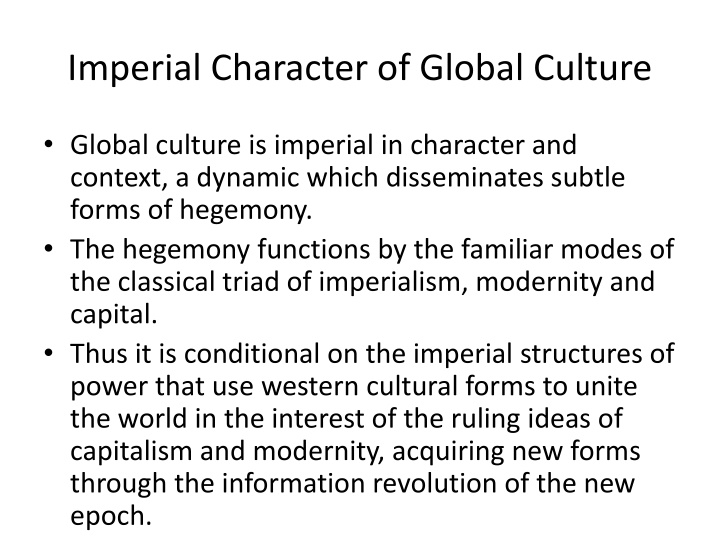
Understanding the Dynamics of Global Culture
Explore the imperial nature of global culture and how it disseminates hegemony through structures of power, Western imperialism, and transcultural processes. Learn about the interaction between global and local cultures in the contemporary world.
Download Presentation

Please find below an Image/Link to download the presentation.
The content on the website is provided AS IS for your information and personal use only. It may not be sold, licensed, or shared on other websites without obtaining consent from the author. If you encounter any issues during the download, it is possible that the publisher has removed the file from their server.
You are allowed to download the files provided on this website for personal or commercial use, subject to the condition that they are used lawfully. All files are the property of their respective owners.
The content on the website is provided AS IS for your information and personal use only. It may not be sold, licensed, or shared on other websites without obtaining consent from the author.
E N D
Presentation Transcript
Imperial Character of Global Culture Global culture is imperial in character and context, a dynamic which disseminates subtle forms of hegemony. The hegemony functions by the familiar modes of the classical triad of imperialism, modernity and capital. Thus it is conditional on the imperial structures of power that use western cultural forms to unite the world in the interest of the ruling ideas of capitalism and modernity, acquiring new forms through the information revolution of the new epoch.
Imperial Character----(contd.) While access to global forms of connectivity, markets and culture is more open now than before, the process of enabling the accession and the agencies that are put in place are ideologically configured structures hooked on to the meta-context of Western imperialism. The second aspect that complicates the linear narratives of globalization emphasizes its nature as a transcultural process, a dialectic of dominant cultural forms and their practices, where the response of the local becomes absolutely critical.
Anthony D. Smiths Global Culture Ecclectic Anthony D. Smith finds the global culture ecclectic as a particle of cultural motifs and styles, underpinned by a universal scientific and technical discourse. But the meaning of the global is translated by the local. Arjun Appadurai criticizes the singular emphasis on homogenization that draws upon the dual terms of Americanization and commoditization .
Arjun Appadurais Critique of the Singular Emphasis on Homogenization As forces from metropolises are brought into new societies they need to become indigenized in one way or the other. This is true of music, housing styles, science and constitutions. Like the global economy and global polity, the idea of global culture is varied. People can now appreciate other cultures and access them more easily than before. But this does not lead to cultural homogenization.
The Global-Local Interface People are still embedded in their local cultures most of the time. But the local has to adjust to the global. The packaging and presentations have altered somewhat. They mediate the global through their local prisms. The global and the local feed on each other-the interface. The growth of transnational civil societies and the opportunities and challenges before local communities in contemporary society bears ample testimony to this process.
